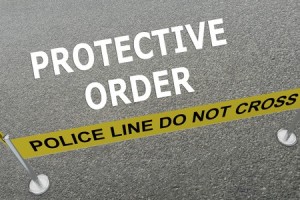Sanctuary for the Abused
Thursday, September 20, 2018
Protective Order Violations

Last winter, police found the bodies of a man and his girlfriend. The man had tracked his girlfriend to her cousin's house, broken down the door, shot her as she called 911, and then turned the gun on himself. Next to the woman's body, the police found a court order directing the murderer to have no contact with the victim. The killer had violated that order four times before murdering his victim.
Domestic violence victims often seek protective orders-court orders that direct individuals to refrain from specified conduct-to avoid future violence. In many cases, the court orders succeed in deterring the offenders. Yet abusers often defy the orders-placing victims at high risk for future violence.
Who Gets Protective Orders
Research suggests that most victims seek orders of protection only after experiencing serious levels of victimization. Most women seeking protective orders have experienced physical assault; threats of harm or death; sexual abuse; threats with a weapon, stalking, and harassment; or assaults on their children.
1 Studies also show that victims usually seek protective orders only after long exposure to abuse.
2 Of the total number of victims of abuse, only a small percentage ever obtain protective orders-16.4 percent of rape victims, 17.1 percent of physical assault victims, and 36.6 percent of stalking victims.
Protective Order Violations
Violations of protective orders are both common and often associated with significant danger to the victim. One two-year follow-up study of batterers found that almost one-half (48.8 percent) re-abused the victims after the issuance of a protective order.4 Stalking victims, in particular, report frequent violations. A 1998 National Institute of Justice study found that of stalking victims who seek protective orders, 69 percent of the women and 81 percent of the men said their stalker violated the order.5 And in approximately 21 percent of cases, violence and stalking escalate after the protective order is issued.6
Multiple Violations as Stalking
"In cases with more than one violation of a protective order," says Sergeant Cari Graves, director of the Colorado Springs Police Department's Domestic Violence Enhanced Response Team (DVERT) program, "two things are evident. There is a clear ‘course of conduct' as defined in many stalking statutes. It also shows that the true intent of the perpetrator is to control and intimidate the victim despite the legal restraint placed on him by a judge." With violations of protective orders, the course of conduct may involve repeatedly following or harassing the victim or sometimes abusing another person-placing the victim in reasonable fear of harm. Repeated violations of protective orders, then, constitute stalking. "And even the first violation of a protective order may in fact be stalking," says Stalking Resource Center director Tracy Bahm, "because the original series of events that caused the victim to seek the court's protection may fit the legal definition of the crime."
Yet the connections between protection order violations and stalking violations-and the resulting danger to victims-are not always evident to law enforcement. One possible reason, as retired Lieutenant Mark Wynn of the Nashville Police Department points out, is that law enforcement officers often view protective orders "as a civil issue; something that is involved in divorce, custody or visitation," rather than a criminal matter. Studies show that even when states have mandatory arrest laws for violations of protective orders, law enforcement officers do not always arrest offenders who commit these violations. One study showed that only 44 percent of protective order violations resulted in arrest and that the likelihood of arrest decreased as the number of prior incidents increased.
Another reason these connections are not always clear is that law enforcement usually investigates one offense at a time and does not always look for a pattern of violations. "Law enforcement officers tend to view calls for service in a ‘snapshot' view," says Sergeant Graves. "A single violation of a protection order may seem to involve only a simple investigation and a possible arrest. But if the officer should dig deeper, continues Graves, "she might find that often the victim will disclose previously reported or unreported violations of the same order." In that context, the "single" violation becomes part of a more serious and threatening picture-stalking.
Overlooking the threat posed by protection order violations is unwise and dangerous, Wynn believes. Violations of civil protective orders are criminal offenses and, he says, often a signal to law enforcement "that something worse is about to happen. When offenders thumb their noses at the court, this is an indicator that you've got high lethality on your hands." For this reason some states, such as Florida, have added a provision to their stalking laws that defines more than one violation of a protective order as felony stalking.8
Implications for Law Enforcement and Prosecutors
Experts agree that law enforcement must take protective order violations seriously. Supervisory Special Agent Eugene Rugala of the Behavioral Analysis Unit at the FBI's National Center for the Analysis of Violent Crime in Quantico, Virginia, says that "investigators should review protection order violations on a case-by-case basis," paying close attention to the context of the violations and the reason that the order was obtained. Rugala stresses that a pattern of violations can alert police about the perpetrator's intent and the threat of serious harm to the victim. And, he adds, "the presence of the order may even escalate the risk to some victims."
Because of the danger to victims, law enforcement should carefully track violations and consistently arrest violators. Departments that adopt these proactive strategies often notice a drop in homicides. In Orlando, Florida, for example, the Investigations Division of the Orange County Sheriff's Department, systematically tracks stalkers and protection order violators. The division "views all cases involving domestic violence and violations of protective orders as stalking and as potential homicides," says Lieutenant Kevin Behan. The department's well-trained, specialized "Stalking Team," equipped with a broad array of high-tech equipment, conducts surveillance and gains intelligence on stalkers (and suspected stalkers) and their activities. This approach has been effective, helping to reduce the overall rate of homicides related to domestic violence from 34 percent in 1998 to 21 percent in 2003.
Prosecutors who handle these cases should appreciate the dangers involved and take the appropriate precautions. They should obtain full criminal histories of offenders and examine the petitions for protective orders filed by victims, which often include vital details that investigations sometimes miss. Prosecutors should review all other reports of violations of the order as well as the underlying reports for domestic violence. Because protection order violators defy court orders, prosecutors also should seek high bail, or no bail, in these cases. They should charge stalking when possible and use the stalking laws to show judges and juries the entire context (i.e., stalker's previous pattern of conduct) for each violation. Prosecutors should also seek jail time to contain offenders and to deter future violations when possible.
Conclusion
Multiple violations of protective orders are stalking. Law enforcement and prosecutors who understand this connection are better equipped to investigate the context of violations, assess the danger, and prevent serious harm to stalking victims who have sought protective orders.
If you have further insights on the relationship between stalking and protection order violations, the Stalking Resource Center would like to hear from you. Please contact us at src@ncvc.org.
Endnotes
1 Carol Jordon, "Intimate Partner Violence and the Justice System: An Examination of the Interface," Journal of Interpersonal Violence Vol. 19, No.12 (December 2004): 1423.
2 Ibid., 1424.
3 Patricia Tjaden and Nancy Thoennes, Extent, Nature, and Consequences of Intimate Partner Violence , (Washington, DC: National Institute of Justice, 2000), NCJ 181867.
4 A.R. Klein, "Re-abuse in a Population of Court-restrained Male Batterers: Why Restraining Orders Don't Work," in E. Buzawa and C. Buzawa, eds., Do Arrests and Restraining Orders Work?, (Thousand Oaks, CA: Sage, 1996), 192-213.
5 Patricia Tjaden and Nancy Thoennes, Stalking in America: Findings from the National Violence Against Women Survey , (Washington, DC: U.S. Department of Justice, National Institute of Justice, Washington, DC, 1998).
6 B. Spitzberg, "The Tactical Topography of Stalking Victimization and Management," Trauma, Violence, and Abuse Vol. 3, No. 4, (2002): 261-288. Of 32 studies in this meta-analysis of stalking studies, 9 reported that incidents of violence or stalking followed the issuance of a protective order 21 percent of the time.
7 R. J. Kane, "Police Responses to Restraining Orders in Domestic Violence Incidents: Identifying the Custody-Threshold Thesis," Criminal Justice and Behavior Vol. 27, No. 2 (2000): 561.
8 Fla. Stat § 784.048, (4). Stalking; definitions; penalties . Amended 2004.
BOTH MEN AND WOMEN CAN BE ABUSERS.
Labels: incident, narcisissts, protective order, psychopaths, restraining order, sociopaths, stalkers, stalking, tro, violation




























0 Comments:
Post a Comment
<< Home